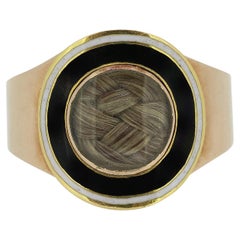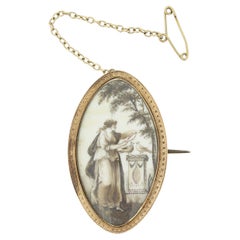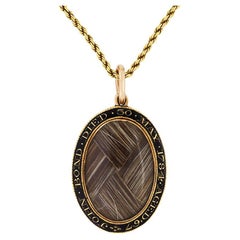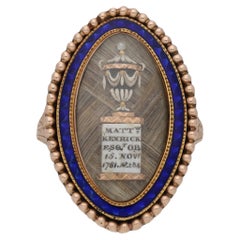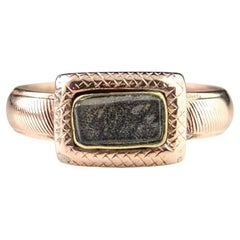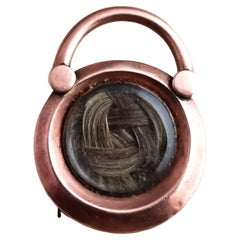Georgian Mourning Jewelry
Antique 1790s Georgian Fashion Rings
Gold, Rose Gold, Enamel
Antique 1820s Unknown Georgian Band Rings
18k Gold
Antique 18th Century Brooches
Gold, Yellow Gold, Enamel
Antique 1780s Unknown Georgian Pendant Necklaces
15k Gold, Enamel
Antique 1780s British Georgian Fashion Rings
Enamel
Antique 19th Century British Georgian Band Rings
9k Gold, Rose Gold
Antique Early 1800s British Georgian Brooches
Garnet, Gold
Antique 1830s British Georgian Cluster Rings
Amethyst, Yellow Gold
Antique 19th Century British Georgian Brooches
9k Gold, Rose Gold
Antique 1810s British Georgian Fashion Rings
Enamel
Antique 18th Century Georgian Band Rings
Yellow Gold
Antique 1850s English Georgian Fashion Rings
Gold
Antique 1770s Georgian Engagement Rings
Gold, Yellow Gold, Enamel
Antique 1810s Georgian Band Rings
Gold, White Gold, Yellow Gold
Antique 1770s Georgian More Rings
Diamond, 18k Gold
Antique 18th Century Georgian Engagement Rings
Diamond, Pearl, Gold, Yellow Gold, Enamel
Antique 18th Century Georgian Engagement Rings
Diamond, Pearl, Gold, Yellow Gold, Enamel
Antique Early 19th Century British Georgian Pendant Necklaces
9k Gold
Antique Early 19th Century Georgian Link Bracelets
Gold, 18k Gold
Antique Early 19th Century Unknown Georgian Brooches
Pearl, 10k Gold
Antique Early 19th Century Georgian Band Rings
Gold, 14k Gold
Antique 1820s British Georgian Band Rings
Yellow Gold, Enamel, Gold
Antique 1820s European Georgian Brooches
14k Gold
Antique 1820s British Georgian Band Rings
Gold, Enamel
Antique Late 18th Century British Georgian Solitaire Rings
Rose Gold
Antique 1820s British Georgian Signet Rings
Diamond, 18k Gold, Enamel
Antique 1820s British Georgian Brooches
14k Gold
Antique 18th Century Unknown Georgian Brooches
14k Gold, Yellow Gold, Enamel
Antique 1830s British Georgian More Rings
Crystal, Pearl
Antique 1820s Band Rings
18k Gold, Enamel
Antique Early 19th Century British Georgian Brooches
Pearl, Gold, Enamel
Antique Late 18th Century British Georgian Fashion Rings
18k Gold, Yellow Gold
Antique 1820s British Georgian More Rings
Pearl, Gold, Enamel
Antique Late 18th Century British Georgian Band Rings
Yellow Gold, Enamel
Antique Early 19th Century British Georgian Signet Rings
Pearl, Crystal, Gold, Enamel, 18k Gold
Antique 1820s English Georgian Fashion Rings
Onyx, Garnet, Enamel, 15k Gold, Gold
Antique 1820s English Georgian Dangle Earrings
Gold, 15k Gold, Enamel
Antique Early 1800s Engagement Rings
Gold, Yellow Gold, Enamel
21st Century and Contemporary American Georgian Beaded Necklaces
Cultured Pearl, Natural Pearl, Ruby, Pink Sapphire, Turquoise, Sterling ...
Antique 1810s Cluster Rings
Amethyst, Chrysoberyl, Yellow Gold
Antique Late 18th Century British Georgian Cluster Rings
Diamond, 18k Gold
Antique 18th Century Band Rings
Gold, 18k Gold, Enamel
Antique 19th Century Unknown Georgian Pendant Necklaces
Garnet, Gold, 14k Gold
Antique 18th Century British Georgian Band Rings
22k Gold, Yellow Gold, Enamel
Antique Late 18th Century British Georgian Fashion Rings
18k Gold, Yellow Gold
Antique Early 19th Century British Georgian Brooches
Agate, 15k Gold, Yellow Gold
Antique 1820s Georgian Fashion Rings
Sapphire, Diamond, Silver, Yellow Gold, 18k Gold, Gold
Antique 18th Century British Georgian Signet Rings
18k Gold, Yellow Gold, Enamel
Antique 18th Century More Rings
Yellow Gold, Enamel
Antique 1820s British George IV Pendant Necklaces
Pearl, Gold, 14k Gold
Antique Mid-19th Century Victorian Brooches
Pearl, 14k Gold
Antique 1820s Band Rings
18k Gold, Yellow Gold
Antique 1780s European George III Cocktail Rings
Diamond, 18k Gold, Silver
Antique 1820s Brooches
18k Gold, Yellow Gold, Enamel
Antique 1810s Georgian Solitaire Rings
Garnet, 14k Gold, Enamel
Antique 1770s Georgian Cluster Rings
Diamond, Pearl, Rose Gold, Silver
Antique Early 1800s British Georgian Band Rings
Amethyst, Gold
Antique Early 19th Century British Georgian Cluster Rings
Garnet, Pearl, 9k Gold, Rose Gold
Antique 1820s Unknown Georgian More Rings
Natural Pearl, 18k Gold, Enamel
Antique Early 19th Century British Georgian Pendant Necklaces
Pearl, 15k Gold
- 1
Shopping for Antique Georgian Mourning Jewelry?
While it first came into fashion during the Georgian period, mourning jewelry had a resurgence during the Victorian era. With respect to Victorian jewelry, the era’s Grand Period (ca. 1860–80) is most often associated with antique mourning jewelry.
Scholars note that Romantic period jewelry was a celebration of the young monarch’s love. But everything changed with the premature death of Prince Albert in 1861. This traumatic event changed the way the Queen’s public perceived her and in the way she presented herself. The heartbroken Queen donned black clothing and went into mourning. Her taste for jewelry reflected her deep sorrow as well.
Victorian mourning jewelry still tends to be romantic, a way to honor the memory of the departed, while Georgian mourning jewelry was more focused on the macabre. During the Georgian era, portrait miniatures, hair jewelry, cameos, enamels and micromosaics were fashionable.
Most materials used in antique mourning jewelry were also black, the universal signifier of grief. Naturally jet, onyx and gutta percha were the most popular. Dark red garnets and black enamel were often used in combination with these materials (enameling is one of the oldest forms of surface decoration). Hair jewelry became incredibly intricate, and some pieces were made with strands from various family members woven into a complex floral pattern.
“Unlike most other pieces of antique jewelry, mourning jewelry has an easily accessible history,” Lindsay Salmon, part of the duo behind jewelry line Erica Weiner.
“These pieces are often inscribed with a name, a date of death and the age of the deceased. For many people, myself included, having this information about the person a piece of jewelry was made to commemorate is both fascinating and romantic; it grounds the piece in a historical and personal context.”
Find a collection of antique Georgian mourning jewelry on 1stDibs.
A Close Look at Georgian Jewelry
Georgian jewelry is named for the monarchies of the four King Georges, who in succession ruled England starting in 1714 (plus King William’s reign, which lasted until 1837). A slew of beautiful pieces were produced during the period, and today antique Georgian rings, necklaces and other accessories are coveted by fine jewelry collectors.
There are certain features that distinguish jewelry from this era, including the fact that pieces from the 18th and early 19th centuries were handmade (so don’t let the absence of a maker’s mark lead you to believe otherwise). Antique Georgian jewelry also has a certain “look.” It’s a bit gray because stones were often set in silver, and because stonecutting techniques were not as advanced as they are today, the gems do not possess the level of sparkle to which we have become accustomed.
Intricate metalworking techniques such as repoussé (the hammering of metal into ornate designs) and cannetille (a method of working the gold wire to make it look woven) allowed goldsmiths to really flex their muscles. These gold pieces, either on their own or combined with gemstones, made for highly original and dramatic jewelry. The era also saw pieces with ornately woven strands of human hair.
Pearls, along with colored gemstones like garnets, rubies and sapphires, were widely used in Georgian jewelry. These were often cut in the shape of a cabochon or teardrop. It was fashionable to combine garnets or rubies with seed pearls. In Georgian diamond rings, popular cuts for diamonds included rose, old mine and table. Around the 1780s, paste jewelry, or hand-cut glass on foil, was used to imitate diamonds.
Browse a collection of antique Georgian diamond rings, earrings, brooches and other authentic Georgian jewelry today on 1stDibs.
Why Gold Shines in Jewelry Craftsmanship
Gold is the feel-good metal, the serotonin of jewelry. Wear vintage and antique gold necklaces, watches, gold bracelets or gold rings and you feel happy, you feel dressed, you feel, well, yourself.
Gold, especially yellow gold, with its rich patina and ancient pedigree going back thousands of years, is the steady standby, the well-mannered metal of choice. Any discussion of this lustrous metal comes down to a basic truth: Gold is elementary, my dear. Gold jewelry that couples the mystique of the metal with superb design and craftsmanship achieves the status of an enduring classic. Many luxury houses have given us some of our most treasured and lasting examples of gold jewelry over the years.
Since its founding, in 1837, Tiffany & Co. has built its reputation on its company jewelry as well as its coterie of boutique designers, which has included Jean Schlumberger, Donald Claflin, Angela Cummings and Elsa Peretti. There are numerous gold Tiffany classics worth citing. Some are accented with gemstones, but all stand out for their design and the workmanship displayed.
For the woman who prefers a minimalist look, the Tiffany & Co. twist bangle (thin, slightly ovoid) is stylishly simple. For Cummings devotees, signature pieces feature hard stone inlay, such as her pairs of gold ear clips inlaid with black jade (a play on the classic Chanel black and tan), or bangles whose design recalls ocean waves, with undulating lines of lapis lazuli and mother-of-pearl. And just about any design by the great Jean Schlumberger is by definition a classic.
Even had he eschewed stones and diamonds, Southern-born David Webb would be hailed for the vast arsenal of heavy gold jewelry he designed. Gold, usually hammered or textured in some manner, defines great David Webb jewelry. The self-taught jeweler made very au courant pieces while drawing inspiration from ancient and out-of-the-way sources — East meets West in the commanding gold necklaces made by Webb in the early 1970s. The same could be said for his endlessly varied gold cuffs.
In Europe, many houses have given us gold jewelry that sets the highest standard for excellence, pieces that were highly sought after when they were made and continue to be so.
Numerous designs from Cartier are homages to gold. There are the classic Trinity rings, necklaces and bracelets — trifectas of yellow, white and rose gold. As a testament to the power of love, consider the endurance of the Cartier Love bracelet.
Aldo Cipullo, Cartier’s top in-house designer from the late 1960s into the early ’70s, made history in 1969 with the Love bracelet. Cipullo frequently said that the Love bracelet was born of a sleepless night contemplating a love affair gone wrong and his realization that “the only remnants he possessed of the romance were memories.” He distilled the urge to keep a loved one close into a slim 18-karat gold bangle.
BVLGARI and its coin jewelry, gemme nummarie, hit the jackpot when the line launched in the 1960s. The line has been perennially popular. BVLGARI coin jewelry features ancient Greek and Roman coins embedded in striking gold mounts, usually hung on thick link necklaces of varying lengths. In the 1970s, BVLGARI introduced the Tubogas line, most often made in yellow gold. The Tubogas watches are classics, and then there is the Serpenti, the house's outstanding snake-themed watches and bracelets.
A collection called Monete that incorporated the gold coins is one of several iconic BVLGARI lines that debuted in the 1970s and ’80s, catering to a new generation of empowered women. Just as designers like Halston and Yves Saint Laurent were popularizing fuss-free ready-to-wear fashion for women on the go, BVLGARI offered jewels to be lived in.
Since Van Cleef & Arpels opened its Place Vendôme doors in 1906, collection after collection of jewelry classics have enchanted the public. As predominantly expressed in a honeycomb of gold, there is the Ludo watch and accessories, circa the 1920s, and the golden Zip necklace, 1951, whose ingenious transformation of the traditional zipper was originally proposed by the Duchess of Windsor. Van Cleef's Alhambra, with its Moroccan motif, was introduced in 1968 and from the start its popularity pivoted on royalty and celebrity status. It remains one of VCA’s most popular and collected styles.
Mention must be made of Buccellati, whose name is synonymous with gold so finely spun that it suggests tapestry. The house’s many gold bracelets, typically embellished with a few or many diamonds, signified taste and distinction and are always in favor on the secondary market. Other important mid-20th-century houses known for their gold-themed jewelry include Hermès and Ilias Lalaounis.
Find a stunning collection of vintage and antique gold jewelry on 1stDibs.
- 1stDibs ExpertApril 5, 2022Yes, some jewelers still make mourning jewelry. Mourning jewelry was very popular in the Georgian era and experienced a resurgence in the Victorian Era when Queen Victoria wore it in memory of Prince Albert after he passed. Today, there is more versatility in what is considered mourning jewelry and limitless options for customizing it. Find vintage and contemporary mourning jewelry from some of the world’s top boutiques on 1stDibs.
- Did men wear mourning jewelry?1 Answer1stDibs ExpertApril 5, 2022Yes, men wore mourning jewelry as well as women. It became popularized during the Victoria era, but was a tradition that has stretched in history far back before this period. Shop an array of authentic mourning jewelry from top sellers on 1stDibs.
Read More
These Georgian Garnet Bracelets Are Absolutely Enchanting
The rarity of this beautifully preserved matched set cannot be overstated.
Be Entranced by Intricate Georgian-Era Jewelry
From diamonds to glass, gold to iron, get to know the stories behind the materials and techniques that defined the jewelry of this era.
How to Buy a Vintage or Antique Engagement Ring
Will your beloved be enchanted by an Edwardian ring or a trendy Art Deco piece? We clue you into period styles and tips for finding the perfect ring.
